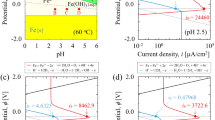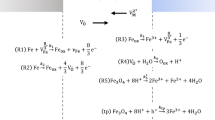Abstract
We are interested in a reduced model for corrosion of iron, in which ferric cations and electrons evolve in a fixed oxide layer subject to a self-consistent electrostatic potential. Reactions at the boundaries are modeled thanks to Butler–Volmer formulas, whereas the boundary conditions on the electrostatic potential model capacitors located at the interfaces between the materials. Our model takes inspiration in existing papers, to which we bring slight modifications in order to make it consistent with thermodynamics and its second principle. Building on a free energy estimate, we establish the global in time existence of a solution to the problem without any restriction on the physical parameters, in opposition to previous works. The proof further relies on uniform estimates on the chemical potentials that are obtained thanks to Moser iterations. Numerical illustrations are finally provided to highlight the similarities and the differences between our new model and the one previously studied in the literature.


Similar content being viewed by others
References
Alikakos, N.D.: \(L^p\) bounds of solutions of reaction–diffusion equations. Commun. Partial Differ. Equ. 4(8), 827–868 (1979)
Bataillon, C.: Boundary conditions and parameters involved in the Diffusion Poisson Coupled Model. Pers. Commun. (2022)
Bataillon, C., Bouchon, F., Chainais-Hillairet, C., Desgranges, C., Hoarau, E., Martin, F., Tupin, M., Talandier, J.: Corrosion modelling of iron based alloy in nuclear waste repository. Electrochimica Acta 55(15), 4451–4467 (2010)
Bataillon, C., Bouchon, F., Chainais-Hillairet, C., Fuhrmann, J., Hoarau, E., Touzani, R.: Numerical methods for simulation of a corrosion model with moving numerical methods for simulation of a corrosion model with moving oxide layer. J. Comput. Phys. 231(18), 6213–6231 (2012)
Blakemore, J.: The parameters of partially degenerate semiconductors. Proc. Phys. Soc. Lond. A 65, 460–461 (1952)
Breden, M., Chainais-Hillairet, C., Zurek, A.: Existence of traveling wave solutions for the Diffusion Poisson Coupled Model: a computer-assisted proof. ESAIM Math. Model. Numer. Anal. 55(4), 1669–1697 (2021)
Brezis, H.: Les opérateurs monotones. Séminaire Choquet. Initiation à l’analyse 5(2), talk:10 (1965–1966)
Brezis, H.: Opérateurs maximaux monotones et semi-groupes de contractions dans les espaces de Hilbert. No. 50 in Notas de Matemática. North-Holland, Amsterdam (1973)
Brezis, H.: Functional analysis. Sobolev spaces and partial differential equations. Universitext. Springer, New York (2011)
Cancés, C., Venel, J.: On the square-root approximation finite volume scheme for nonlinear drift–diffusion equations. Comptes Rendus. Mathématique 361, 525–558 (2023)
Chainais-Hillairet, C., Bataillon, C.: Mathematical and numerical study of a corrosion model. Numer. Math. 110(1), 1–25 (2008)
Chainais-Hillairet, C., Colin, P.-L., Lacroix-Violet, I.: Convergence of a finite volume scheme for a corrosion model. Int. J. Finite Vol. 12, 27 (2015)
Chainais-Hillairet, C., Gallouët, T.O.: Study of a pseudo-stationary state for a corrosion model: existence and numerical approximation. Nonlinear Anal. Real World Appl. 31, 38–56 (2016)
Chainais-Hillairet, C., Lacroix-Violet, I.: The existence of solutions to a corrosion model. Appl. Math. Lett. 25(11), 1784–1789 (2012)
Chainais-Hillairet, C., Lacroix-Violet, I.: On the existence of solutions for a drift–diffusion system arising in corrosion modelling. DCDS-B 20(1), 77–92 (2014)
Farrell, P., Koprucki, T., Fuhrmann, J.: Computational and analytical comparison of flux discretizations for the semiconductor device equations beyond Boltzmann statistics. J. Comput. Phys. 346, 497–513 (2017)
Gajewski, H.: On the uniqueness of solutions to the drift–diffusion model of semiconductor devices. Math. Models Methods Appl. Sci. 4(1), 121–133 (1994)
Gajewski, H., Gröger, K.: On the basic equations for carrier transport in semiconductors. J. Math. Anal. Appl. 113(1), 12–35 (1986)
Gajewski, H., Gröger, K.: Semiconductor equations for variable mobilities based on Boltzmann statistics or Fermi-Dirac statistics. Math. Nachr. 140, 7–36 (1989)
Gajewski, H., Gröger, K.: Initial-boundary value problems modelling heterogeneous semiconductor devices. In: Surveys on Analysis, Geometry and Mathematical Physics, Teubner-Texte Mathematics. Teubner, Leipzig, vol. 117, pp. 4–53 (1990)
Gajewski, H., Gröger, K.: Reaction–diffusion processes of electrically charged species. Math. Nachr. 177, 109–130 (1996)
Glitzky, A.: Analysis of spin-polarized drift–diffusion models. PAMM 8(1), 10717–10718 (2008)
Glitzky, A.: Analysis of electronic models for solar cells including energy resolved defect densities. Math. Methods Appl. Sci. 34(16), 1980–1998 (2011)
Glitzky, A.: An electronic model for solar cells including active interfaces and energy resolved defect densities. SIAM J. Math. Anal. 44(6), 3874–3900 (2012)
Glitzky, A., Gröger, K., Hünlich, R.: Free energy and dissipation rate for reaction diffusion processes of electrically charged species. Appl. Anal. 60(3–4), 201–217 (1996)
Glitzky, A., Hünlich, R.: Energetic estimates and asymptotics for electro–reaction–diffusion systems. ZAMM J. Appl. Math. Mech. 77(11), 823–832 (1997)
Heida, M.: Convergences of the squareroot approximation scheme to the Fokker–Planck operator. Math. Models Methods Appl. Sci. 28(13), 2599–2635 (2018)
Lions, J.-L.: Quelques méthodes de résolution de problemes aux limites non linéaires. Dunod (1969)
Mielke, A.: A gradient structure for reaction–diffusion systems and for energy–drift–diffusion systems. Nonlinearity 24(4), 1329–1346 (2011)
Moser, J.: A new proof of de Giorgi’s theorem concerning the regularity problem for elliptic differential equations. Commun. Pure Appl. Math. 13, 457–468 (1960)
Moussa, A.: Some variants of the classical Aubin–Lions lemma. J. Evol. Equ. 16(1), 65–93 (2016)
Onsager, L.: Reciprocal relations in irreversible processes. I. Phys. Rev. 37(4), 405–426 (1931)
Onsager, L.: Reciprocal relations in irreversible processes. II. Phys. Rev. 38(12), 2265–2279 (1931)
Van Roosbroeck, W.: Theory of the flow of electrons and holes in germanium and other semiconductors. Bell Syst. Tech. J. 29, 560–607 (1950)
Acknowledgements
The authors warmly thank Christian Bataillon for his kind feedback on the model. This Project has received funding from the European Union’s Horizon 2020 research and innovation programme under Grant Agreement No 847593 (WP DONUT), and was further supported by Labex CEMPI (ANR-11-LABX-0007-01). C. Cancès also acknowledges support from the COMODO Project (ANR-19-CE46-0002) and C. Chainais-Hillairet from the MOHYCON Project (ANR-17-CE40-0027-01). J. Venel warmly thanks the Inria research center of the University of Lille for its hospitality.
Author information
Authors and Affiliations
Corresponding author
Additional information
Publisher's Note
Springer Nature remains neutral with regard to jurisdictional claims in published maps and institutional affiliations.
Rights and permissions
Springer Nature or its licensor (e.g. a society or other partner) holds exclusive rights to this article under a publishing agreement with the author(s) or other rightsholder(s); author self-archiving of the accepted manuscript version of this article is solely governed by the terms of such publishing agreement and applicable law.
About this article
Cite this article
Cancès, C., Chainais-Hillairet, C., Merlet, B. et al. Mathematical analysis of a thermodynamically consistent reduced model for iron corrosion. Z. Angew. Math. Phys. 74, 96 (2023). https://doi.org/10.1007/s00033-023-01970-6
Received:
Revised:
Accepted:
Published:
DOI: https://doi.org/10.1007/s00033-023-01970-6




